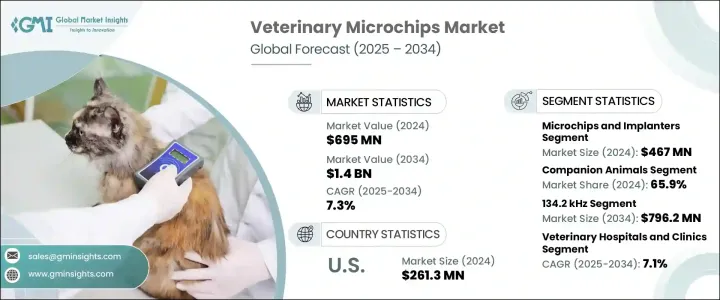
세계의 수의용 마이크로칩 시장은 2024년에는 6억 9,500만 달러로 평가되었고 세계의 반려동물 사육수 증가, 동물의 안전에 대한 관심 증가, 마이크로칩 기술 발전으로, 2034년에는 14억 달러에 달할 것으로 추정되며, CAGR 7.3%로 성장할 전망입니다.
이는 전 세계 반려동물 소유율 증가, 동물 안전에 대한 관심 고조, 마이크로칩 기술의 발전에 힘입은 결과입니다. 반려동물이 가족 구성원으로 인식되는 경우가 늘어나면서, 반려동물 소유 가구에서 신뢰할 수 있는 식별 및 추적 도구 수요가 급증하고 있습니다. 반려동물 소유자들은 마이크로칩이 동물 안전을 보장하는 데 역할을 점점 더 인식하고 있으며, 특히 분실이나 도난 시에 더욱 중요성을 느끼고 있습니다. 이러한 장치는 수의사 협회와 동물 복지 단체에서도 책임감 있는 반려동물 식별을 강조하며 홍보되고 있습니다.

정부의 의무적 마이크로칩 삽입 법규 도입과 규제 기관의 지원은 채택 속도를 더욱 가속화하고 있습니다. 또한 칩 설계 혁신 및 생체 적합성 개선, 소형화, 데이터 기능 강화는 수의사와 반려동물 소유주에게 기술을 더 매력적으로 만들고 있습니다. 이 변화는 특히 신흥 시장에서 증가하는 가처분 소득과 반려동물 인간화 트렌드의 강화로 뒷받침되고 있으며, 이는 사람들이 동물 복지에 더 많은 투자를 유도하고 있습니다.
| 시장 범위 | |
|---|---|
| 시작 연도 | 2024년 |
| 예측 연도 | 2025-2034년 |
| 시작 금액 | 6억 9,500만 달러 |
| 예측 금액 | 14억 달러 |
| CAGR | 7.3% |
마이크로칩 및 임플란트 부문은 2024년에 4억 6,700만 달러를 기록했습니다. 이 우위는 정책 의무화, 소비자 인식 향상, 접근 가능한 가격의 조합에서 비롯됩니다. 수의과 병원, 보호소, 가축 사육 시설은 사용 편의성과 신뢰성 때문에 현대적인 마이크로칩 솔루션을 점점 더 선호하고 있습니다. 기술 업그레이드, 특히 더 긴 내구성과 동물 추적 데이터베이스와의 원활한 통합은 채택을 가속화하고 있습니다.
반려동물 부문은 2024년 66%의 시장 점유율을 차지했으며, 이는 개, 고양이, 소형 동물을 가정용 반려동물로 입양하는 것이 증가함에 따라 마이크로칩 삽입이 특히 도시와 교외 지역에서 증가했기 때문입니다. 가구들은 정서적 유대감과 반려동물 관리 제품 생태계의 성장으로 인해 반려동물 식별에 투자하는 데 더 적극적입니다. 반려동물 관련 지출은 계속 증가하고 있으며, 안전과 추적 가능성은 소유주들의 최우선 과제입니다.
북미의 수의용 마이크로칩 시장은 2024년 41.7%의 시장 점유율을 차지했습니다. 이 지역은 반려동물 소유 문화가 깊게 뿌리내려 있으며, 반려동물을 키우는 가구의 비율이 높습니다.
시장에서의 존재를 확대하기 위해 Dipole RFID, PetLink, Wuxi Fofia Technology, Trovan, Virbac Corporation 등의 기업은 전략적 제휴, 제품 혁신, 유통 확대를 활용하고 있습니다. 이 기업들은 차세대 칩 기술에 투자하고 디지털 반려동물 기록과의 상호운용성을 개선하며 수의사 네트워크와의 협력을 강화하고 있습니다. 많은 기업은 규제 기준 준수 및 책임감 있는 반려동물 소유를 지원하면서 미개척 지역 진출을 위해 사용자 친화적인 마이크로칩 시스템과 비용 효율적인 솔루션을 도입하고 있습니다.
The Global Veterinary Microchips Market was valued at USD 695 million in 2024 and is estimated to grow at a CAGR of 7.3% to reach USD 1.4 billion by 2034, fueled by rising global pet ownership, rising concern for animal safety, and advancements in microchip technology. With companion animals increasingly regarded as family members, the demand for reliable identification and tracking tools is gaining momentum across pet-owning households. Pet owners are becoming more aware of the role microchips play in ensuring the safety of their animals, especially in cases of loss or theft. These devices are also promoted by veterinary associations and animal welfare organizations, emphasizing responsible pet identification.

The growing implementation of mandatory microchipping laws by governments and support from regulatory bodies has further accelerated adoption. Additionally, innovation in chip design-including improved biocompatibility, miniaturization, and enhanced data capabilities-is making the technology more appealing to veterinarians and pet owners. This shift is supported by increasing disposable income, especially in emerging markets, and a strong pet humanization trend, encouraging people to invest more in animal welfare.
| Market Scope | |
|---|---|
| Start Year | 2024 |
| Forecast Year | 2025-2034 |
| Start Value | $695 Million |
| Forecast Value | $1.4 Billion |
| CAGR | 7.3% |
The microchips and implanters segment generated USD 467 million in 2024, This dominance stems from a combination of policy mandates, increased consumer awareness, and accessible pricing. Veterinary clinics, shelters, and livestock operations increasingly favor modern microchip solutions due to their ease of use and reliability. Technological upgrades, including longer durability and seamless integration with animal tracking databases, accelerate adoption.
The companion animals segment held a 66% share in 2024, driven by the adoption of dogs, cats, and small animals as household pets has increased microchipping, particularly in urban and suburban areas. Households are more willing to invest in pet identification, driven by a combination of emotional attachment and a growing ecosystem of pet care products. Spending on pets continues to rise, with safety and traceability becoming top priorities for owners.
North America Veterinary Microchips Market held a 41.7% share in 2024. The region continues to benefit from a deep-rooted culture of pet ownership, with a high percentage of households including companion animals. This strong adoption trend is supported by a growing inclination toward preventive healthcare and safety measures. The market's strength is further amplified by a robust veterinary services network and advanced pet healthcare technologies, which make microchipping widely accessible across both urban and rural areas.
To expand their market presence, companies like Dipole RFID, PetLink, Wuxi Fofia Technology, Trovan, and Virbac Corporation are leveraging strategic alliances, product innovation, and distribution expansion. These firms are investing in next-gen chip technology, improving interoperability with digital pet records, and collaborating with veterinary networks. Many are introducing user-friendly microchip systems and cost-effective solutions to penetrate underserved regions while ensuring compliance with regulatory standards and supporting responsible pet ownership.